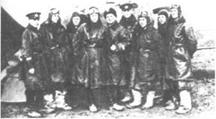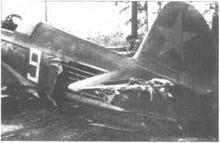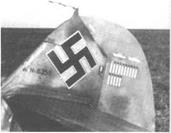Fighter Assault Over the Crimea
|
I |
n the southern combat zone, the Soviets still blocked the entrance to the Crimea. During October, Hitler’s concern over this matter grew. The seizure of the Crimea, the “permanent aircraft carrier” from where Soviet bombers threatened the Romanian oil fields, was of immense importance to the German strategic position.
The main obstacle to the German offensive was the strong VVS forces allocated to this area. JG 77 (to which I.(J)/LG 2 was assigned while I./JG 77 operated on the Arctic front) had originally been allocated to this area. But the demands in the Rostov sector, two hundred miles to the east, had left III./JG 77 as the only Gruppe of JG 77 in the skies over the Crimea. For this reason, IL/JG 3 had been shifted from the central combat zone to the Crimea. This force did not suffice to break the back of the VVS-Black Sea Fleet, and it was evident that further fighter reinforcements had to be brought in. Although there was mounting Soviet air activity that considerably delayed the advance of the northern wing of Army Group South toward the industrial area in the Donets Basin, the only fighter unit in this sector, III./JG 52, was transferred to the Crimean front.
On October 23 three Jagdgruppen—1I./JG 3, 111./ JG 52, and III./JG 77—took off from the air base at Chaplinka, north of the Perekop Isthmus, to clear the Crimean skies once and for all. Oberst Werner Molders, the new inspector of the Fighter Air Arm, took personal charge of these German fighter operations.
The Soviet airmen wrere shocked at the sudden onslaught by such large groups of aggressive enemy fighters. Dozens of Soviet aircraft fell prey to the merciless fighter attacks from above. Finally, Soviet superiority in the air over Perekop was broken.
October 23, 1941, brought a brutal end to the Soviet piggy-back Zveno tactic. 63 BAB/Y’VS-ChF launched two TB-3s escorted by eleven I-15bis and eight 1-153s against artillery positions near Perekop. As large numbers of Bf 109s suddenly appeared ahead of the target area, the 1-16 fighter-bombers were jettisoned. Kapitan Arseniy Shubikov, the able commander of 2 Eskadrilya of 32 ІАР/ChF, led the four l-16s against a tank concentration below. At the same time, a swarm of Bf 109s from III./JG 77 pursued them. Several Messerschmitts attacked the escort with terrifying effect, downing five of the eight l-15bis and 1-153 biplanes of 8 ІАР/ChF. Leutnant Emil Omcrt and his wingman went after the diving l-16s. Closing in at high speed, Omert brought down two, his thirty-third and thirty-fourth victories. In one of the 1-16s, Kapitan Shubikov plunged to his death.
The pilots of 1I./JG 3 and HI./JG 77 shot down eleven MiG-3s, eight Polikarpov I-15bis, and three I-16s without suffering a single loss. The Gruppenkommandeur of ll./JG 3, Hauptmann Gordon Gollob, who had increased his victory tally from seventy-six to eighty-one the previous day, claimed four. An additional eleven Soviet aircraft were claimed shot down by the pilots of III./JG 52 and AAA gunners.
The only loss suffered by the participating Jagdgruppen was a Bf 109 of III./JG 52. This was this unit’s first day of combat over the Crimea, and the pilot lost was the leading ace in 9. Staffel, Feldwebel Ewald “Ede” Diihn. In the air over the Brom factory, I1I./JG 52 fell on six Pe-2s escorted by four Yak-ls of 5./32 IAP/VVS-ChF. According to the Soviet loss list, all six Pe-2s and one Yak-1 were shot down. Shortly after sending his twenty-third victim, a Pe-2, to the ground, Ede Diihn was last seen pursuing another bomber at low level.
Following the October 23 massacre, the Soviet aviation regiments in the Crimea were in complete disarray. Several experienced airmen had failed to return from the missions this day, and others were hospitalised with bad injuries. Apart from the large numbers of aircraft destroyed, there were damaged aircraft in need of repair before they could be used again. But the greatest blow was dealt to the fighting spirit of the airmen. What discouraged them further were the replacement aircraft brought in from the mainland. Proud Yak-1, MiG-3, and Pe-2 pilots found that they had to fly obsolete aircraft models again—I-16s, l-153s, and SBs. The bulk of the new modern aircraft emerging from the factories was earmarked for the defense of Moscow.
|
|
Feldwebel Johann Pichler of 7./JG 77 scored his fifteenth victory against one of the 1-15s” (probably l-15bis) shot down during the massacre on 32 ІАР/ChF over Perekop on October 23.1941, Later that day, Pichler proudly took this photo of his victory markings on the rudder of his Bf 109. One of the two ships painted above the victory markings indicates the bomb hit that Pichler scored on the British battleship Valiant north of Crete on May 22,1941. Pichler was in almost constant front-line service from August 1940 to August 1944, flying about seven hundred sorties and scoring a total of seventy-five victories. On August 30,1944, he ended up in Soviet confinement when Bucharest, where he was hospitalized, was seized by the Red Army. (Photo: Pichler via Norrie.)
On October 24 the Soviet presence in the air was weaker than ever in the Perekop skies. Faced with Bf 109 fighters, the Soviet bombers jettisoned their bombs and banked away. Next, it was the turn of the Soviet ground troops to feel wrath from the air. Large numbers of Stukas and horizontal bombers broke up the Soviet defensive positions. German shock troops did the final job with flamethrowers and hand grenades. Three days later, the entire Crimean front collapsed.
According to German sources, 140 Soviet planes were shot down during the final battle over the Perekop front, from October 18 to 24: 124 by German fighters and 16 by ground fire.
Suffering heavy losses during the next days and with no available replacements, the number of Soviet aircraft in the Crimea diminished rapidly. During the last seven days of October, 5 Eskadrilya/32 IAP/VVS-ChF lost fifteen of the seventeen Yak-ls it had on the evening of October 23.1II./JG 52, claiming more than forty victories during this period, w’as responsible for almost all of these losses. The group’s Leutnant Hermann Graf alone w’as credited with five “1-6Is” between October 24 and 28. Fighting back desperately, Soviet Leytenant


![]()
 Konstantin Alekseyev was credited with three victories during a ten-day period.
Konstantin Alekseyev was credited with three victories during a ten-day period.
On October 25, 5./32 IAP/VVS – ChF was left with only four Yak-ls to escort a group of Pe-2s against the advancing German troops. This elite Soviet squadron, led by Starshiv Leytenant Mikhail Avdeyev following the loss of Kapitan Ivan Lyubimov in September, was challenged by fourteen Messer – schmitts from 9./JG 52, including one piloted by Hermann Graf. And Oberst Werner Molders himself directed the air combat by radio from the forward trenches. “The hated, yellow-bellied Bf 109s flew higher than us,” recalls Mikhail Avdeyev. Nevertheless, the Yakovlev pilots managed to put up a gallant fight.
Oberleutnant Dieter Zehl’s Bf 109 was shot down, its pilot listed as missing. But the “1-61” claimed by Hermann Graf (his seventeenth victory’) probably was Mikhail Avdeyev’s Yak-1, which returned to base with thirty-two bullet holes. A week later, 5./32 LAP was pulled out of combat for three weeks so its pilots could journey to pick up new airplanes.
On November 1 the Germans captured Simferopol and shortly afterward were in control of most of the Crimea, except for Sevastopol, which was to hold out for another eight months.
As a finale to the Battle of the Crimea, one of the largest tragedies at sea in history occurred on November 7, 1941. Luftwaffe bombers hit and sank the passenger steamer Armeniya, which was evacuating soldiers and refugees from Sevastopol, in the Black Sea south of Yalta. Of an estimated five thousand people on board, all but eight perished in the sea.
The air battles during the struggle for the Crimea were some of the hardest fought on the Eastern Front during 1941. Between mid-September and the end of October, the Messerschmitt fighters of Fliegerkorps IV claimed approximately three hundred victories against eighteen pilot casualties in the Crimean skies: II./ JG 3, with sixty-seven victories for one pilot killed and one wounded; III./JG 52, with sixty victories for two pilots killed or missing; II./JG 77, with forty-
four victories for three pilots killed or missing, plus two captured and two wounded; IIL/JG 77, with an amazing one hundred fifty-eight victories for three pilots killed and one wounded; and I.(J)/LG 2, with at least six victories for two pilots killed or missing and one wounded.
That the main port of Sevastopol, the greatest bait in the Crimea, remained in Soviet hands was mainly due to the efforts of the Soviet airmen. As the balance sheet was drawn, it showed that they had held the Germans back for as long as it took to build up the defenses of Sevastopol.
The achievements of the Luftwaffe to a large extent relied on a dozen or so skillful fighter aces against whom most Soviet airmen stood little chance.
The Jagdgruppen assigned to the Battle of the Crimea had fought virtually to the “last round." At the end of the battle, the lack of reinforcements and vital supplies such as spare parts and fuel had brought down the Luftwaffe forces in this area to a mere handful of planes. The situation was so grave that some units were actually grounded for several days simply because there were no supplies.
At the end of October, all that remained of the Staffeln of Il./JG 3 were tw’o or three serviceable Bf 109s each.6 A few days later, Il./JG 3 was pulled out of combat and transferred to Germany for two months of rest and recuperation.











